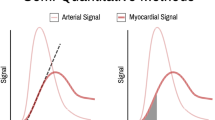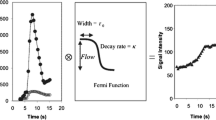Abstract
This article reviews technical aspects and the current status of novel cardiovascular magnetic resonance (CMR) approaches to assessing myocardial perfusion, specifically oxygenation-sensitive magnetic resonance imaging, comparing their diagnostic targets and clinical role with those of other imaging approaches. The paper includes discussions of relevant pathophysiological aspects of myocardial ischemia and the clinical context of revascularization in patients with suspected or known coronary artery disease. Research using oxygenation-sensitive CMR may play an important role for a better understanding of the interplay of coronary artery stenosis, blood flow reduction, and their impact on actual myocardial ischemia.





Similar content being viewed by others
References
Papers of particular interest, published recently, have been highlighted as: • Of importance •• Of major importance
Tonino PAL, Fearon WF, De Bruyne B, Oldroyd KG, Leesar MA, Ver Lee PN, et al. Angiographic versus functional severity of coronary artery stenoses in the FAME study fractional flow reserve versus angiography in multi-vessel evaluation. J Am Coll Cardiol. 2010;55:2816–21.
Nakazato R, Park H-B, Berman DS, Gransar H, Koo B-K, Erglis A, et al. Noninvasive fractional flow reserve derived from CT Angiography (FFRCT) for coronary lesions of intermediate stenosis severity: results from the DeFACTO study. Circ Cardiovasc Imaging. 2013.
Naghavi M. From vulnerable plaque to vulnerable patient: a call for new definitions and risk assessment strategies: Part I. Circulation. 2003;108:1664–72.
Naghavi M, Libby P, Falk E, Casscells SW, Litovsky S, Rumberger J, et al. From vulnerable plaque to vulnerable patient: a call for new definitions and risk assessment strategies: Part II. 2003;1772–8.
Hoffmann U, Bamberg F, Chae CU, Nichols JH, Rogers IS, Seneviratne SK, et al. Coronary computed tomography angiography for early triage of patients with acute chest pain: the ROMICAT (Rule Out Myocardial Infarction using Computer Assisted Tomography) trial. J Am Coll Cardiol. 2009;53:1642–50.
Boden WE, O’Rourke RA, Teo KK, Hartigan PM, Maron DJ, Kostuk WJ, et al. Optimal medical therapy with or without PCI for stable coronary disease. N Engl J Med. 2007;356:1503–16.
Pursnani S, Korley F, Gopaul R, Kanade P, Chandra N, Shaw RE, et al. Percutaneous coronary intervention versus optimal medical therapy in stable coronary artery disease: a systematic review and meta-analysis of randomized clinical trials. Circ: Cardiovasc Interven. 2012;5:476–90.
Murata K, Bhargava V, Ricou F, Ono S, Kambayashi M, Oh BH, et al. The influence of coronary collateral flow on the assessment of myocardial perfusion by videodensitometry. Cardiovasc Res. 1997;33:359–69.
Fearon WF, Aarnoudse W, Pijls NHJ, De Bruyne B, Balsam LB, Cooke DT, et al. Microvascular resistance is not influenced by epicardial coronary artery stenosis severity: experimental validation. Circulation. 2004;109:2269–72.
Greenwood JP, Maredia N, Younger JF, Brown JM, Nixon J, Everett CC, et al. Cardiovascular magnetic resonance and single-photon emission computed tomography for diagnosis of coronary heart disease (CE-MARC): a prospective trial. Lancet. 2012;379:453–60.
Jaarsma C, Leiner T, Bekkers SC, Crijns HJ, Wildberger JE, Nagel E, et al. Diagnostic performance of noninvasive myocardial perfusion imaging using single-photon emission computed tomography, cardiac magnetic resonance, and positron emission tomography imaging for the detection of obstructive coronary artery disease: a meta-analysis. J Am Coll Cardiol. 2012;59:1719–28. Meta-analysis of all currently available techniques to detect myocardial ischemia and its surrogates.
Shin T, Hu HH, Pohost GM, Nayak KS. Three dimensional first-pass myocardial perfusion imaging at 3 T: feasibility study. J Cardiovasc Magn Reson. 2008;10:57.
Jogiya R, Kozerke S, Morton G, De Silva K, Redwood S, Perera D, et al. Validation of dynamic 3-dimensional whole heart magnetic resonance myocardial perfusion imaging against fractional flow reserve for the detection of significant coronary artery disease. J Am Coll Cardiol. 2012;60:756–65. Best evidence so far that 3D CMR first-pass perfusion imaging has a strong clinical potential and compares well with fractional flow reserve as the current gold standard.
Manka R, Jahnke C, Kozerke S, Vitanis V, Crelier G, Gebker R, et al. Dynamic 3-dimensional stress cardiac magnetic resonance perfusion imaging: detection of coronary artery disease and volumetry of myocardial hypoenhancement before and after coronary stenting. J Am Coll Cardiol. 2011;57:437–44.
Lockie T, Ishida M, Perera D, Chiribiri A, De Silva K, Kozerke S, et al. High-resolution magnetic resonance myocardial perfusion imaging at 3.0-Tesla to detect hemodynamically significant coronary stenoses as determined by fractional flow reserve. J Am Coll Cardiol. 2011;57:70–5. First clinical report on high-resolution CMR first-pass perfusion imaging showing the impact of revascularization on myocardial perfusion.
Motwani M, Maredia N, Fairbairn TA, Kozerke S, Radjenovic A, Greenwood JP, et al. High-resolution versus standard-resolution cardiovascular magnetic resonance myocardial perfusion imaging for the detection of coronary artery disease. Circ Cardiovasc Imaging. 2012. Editorial with a detailed discussion on the comparative value of high-resolution vs 3D/full coverage CMR first-pass perfusion imaging.
Phillips LM, Hachamovitch R, Berman DS, Iskandrian AE, Min JK, Picard MH, et al. Lessons learned from MPI and physiologic testing in randomized trials of stable ischemic heart disease: COURAGE, BARI 2D, FAME, and ISCHEMIA. J Nucl Cardiol. 2013. Expert consensus paper on the limitations of clinical decision-making in stable coronary artery disease if based on coronary artery stenosis or the mere presence of inducible ischemia.
Ogawa S, Lee TM, Kay AR, Tank DW. Brain magnetic resonance imaging with contrast dependent on blood oxygenation. Proc Natl Acad Sci U S A. 1990;87:9868–72.
Pauling L, Coryell CD. The magnetic properties and structure of hemoglobin, oxyhemoglobin and carbonmonoxyhemoglobin. Proc Natl Acad Sci U S A. 1936;22:210.
Vohringer M, Flewitt JA, Green JD, Dharmakumar R, Wang J, Tyberg JV, et al. Oxygenation-sensitive CMR for assessing vasodilator-induced changes of myocardial oxygenation. J Cardiovasc Magn Reson. 2010;12:20.
Guensch DP, Fischer K, Flewitt JA, Friedrich MG. Myocardial oxygenation is maintained during hypoxia when combined with apnea—a cardiovascular MR study. Physiol Rep. 2013.
Dharmakumar R, Arumana JM, Tang R, Harris K, Zhang Z, Li D. Assessment of regional myocardial oxygenation changes in the presence of coronary artery stenosis with balanced SSFP imaging at 3.0 T: theory and experimental evaluation in canines. J Magn Reson Imaging. 2008;27:1037–45.
Friedrich MG, Karamitsos TD. Oxygenation-sensitive cardiovascular magnetic resonance. J Cardiovasc Magn Reson. 2013;15:43.
Guensch DP, Fischer K, Flewitt JA, Yu J, Lukic R, Friedrich JA, et al. Breathing-maneuver dependent changes of myocardial oxygenation in healthy humans. Eur Heart J Cardiovasc Imaging. 2013. First proof in humans that breathing maneuvers have a significant impact on myocardial oxygenation.
Wacker CM, Hartlep AW, Pfleger S, Schad LR, Ertl G, Bauer WR. Susceptibility-sensitive magnetic resonance imaging detects human myocardium supplied by a stenotic coronary artery without a contrast agent. J Am Coll Cardiol. 2003;41:834–40.
Friedrich MG, Niendorf T, Schulz-Menger J, Gross CM, Dietz R. Blood oxygen level-dependent magnetic resonance imaging in patients with stress-induced angina. Circulation. 2003;108:2219–23.
Manka R, Paetsch I, Schnackenburg B, Gebker R, Fleck E, Jahnke C. BOLD cardiovascular magnetic resonance at 3.0 tesla in myocardial ischemia. J Cardiovasc Magn Reson. 2010;12:54.
Karamitsos TD, Leccisotti L, Arnold JR, Recio-Mayoral A, Bhamra-Ariza P, Howells RK, et al. Relationship between regional myocardial oxygenation and perfusion in patients with coronary artery disease: insights from cardiovascular magnetic resonance and positron emission tomography. Circ Cardiovasc Imaging. 2010;3:32–40.
Walcher T, Manzke R, Hombach V, Rottbauer W, Wöhrle J, Bernhardt P. Myocardial perfusion reserve assessed by T2-prepared steady-state free-precession Blood Oxygen Level-Dependent (BOLD) Magnetic Resonance Imaging in comparison to fractional flow reserve. Circ Cardiovasc Imaging. 2012. First validation of oxygenation-sensitive CMR against fractional flow reserve as another functional marker of coronary artery stenosis severity, confirming a good correlation.
Karamitsos TD, Arnold JR, Pegg TJ, Francis JM, Birks J, Jerosch-Herold M, et al. Patients with Syndrome X have normal transmural myocardial perfusion and oxygenation: a 3-T cardiovascular magnetic resonance imaging study. Circ Cardiovasc Imaging. 2012;5:194–200. Clinical study showing how oxygenation-sensitive CMR can be helpful in differentiating mere blood flow inhomogeneity from actual oxygenation issues.
Guensch DP, Fischer K, Flewitt JA, Friedrich MG. Impact of intermittent apnea on myocardial tissue oxygenation—a study using oxygenation-sensitive cardiovascular magnetic resonance. PLoS One. 2013;8:e53282. First proof (animal model) that long breath-holds increase myocardial blood supply and, thus, explain the observed increase of oxygenation despite a decrease of ventricular blood oxygen. The study also showed the correlation of these changes with arterial pCO 2.
Zhou X, Tsaftaris SA, Liu Y, Tang R, Klein R, Zuehlsdorff S, et al. Artifact-reduced two-dimensional cine steady state free precession for myocardial blood- oxygen-level-dependent imaging. J Magn Reson Imaging. 2010;31:863–71.
Shea SM, Fieno DS, Schirf BE, Bi X, Huang J, Omary RA, et al. T2-prepared steady-state free precession blood oxygen level-dependent MR imaging of myocardial perfusion in a dog stenosis model. Radiology. 2005;236:503–9.
Compliance with Ethics Guidelines
Conflict of Interest
M. G. Friedrich is board member, advisor, and shareholder of Circle Cardiovascular Imaging Inc., the manufacturer of cvi42, a cardiovascular MR postprocessing and evaluation software. D. P. Guensch and M. G. Friedrich have a pending patent (US Patent Pending 61_680,981) on the use of breathing maneuvers for diagnosing heart disease.
Human and Animal Rights and Informed Consent
This article does not contain any studies with human or animal subjects performed by any of the authors.
Author information
Authors and Affiliations
Corresponding author
Additional information
This article is part of the Topical Collection on Cardiac Magnetic Resonance
Rights and permissions
About this article
Cite this article
Guensch, D.P., Friedrich, M.G. Novel Approaches to Myocardial Perfusion: 3D First-Pass CMR Perfusion Imaging and Oxygenation-Sensitive CMR. Curr Cardiovasc Imaging Rep 7, 9261 (2014). https://doi.org/10.1007/s12410-014-9261-5
Published:
DOI: https://doi.org/10.1007/s12410-014-9261-5




